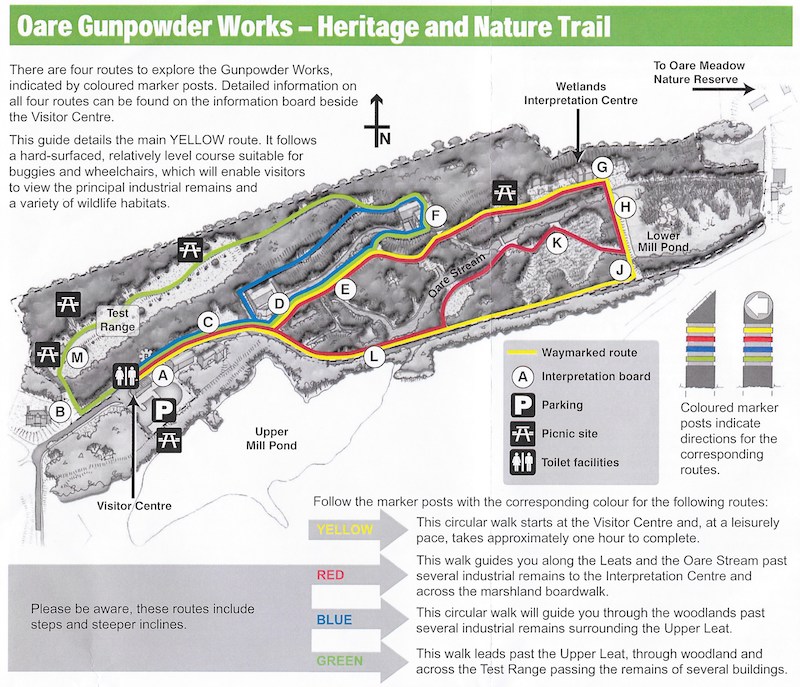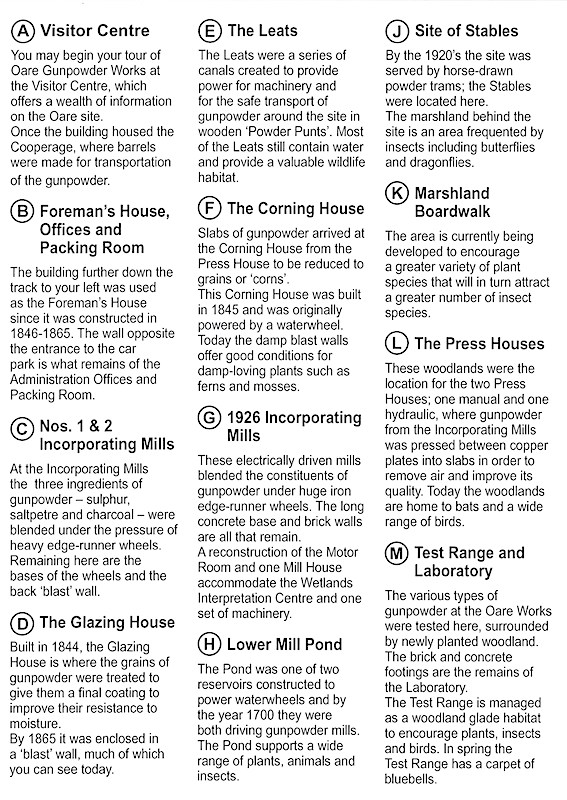Reserve Name: Oare Gunpowder Works Country Park
Managing Authority: Swale Borough Council in partnership with Kent Countryside Management Partnerships
Address:
Phone Number 01795 417529 (Visitor Centre)
Email: Friends of Oare Gunpowder Works: Paul Jessett or KCC Countryside Partnerships Manager, Kate Phillips
Website Visit Website
Google Map Link See Location on Google Map
Access (Transport)
Oare Gunpowder Works is located to the North of Bysing Wood Road, just off the Western Link road (B2045) near Oare village. Just follow the brown ‘country park’ sign from Bysing Wood Road and veer right until you find the visitor centre.
There is some seating by the visitor centre and picnic tables.
Parking & Toilet Provision
There is a small car park adjacent to the visitor centre with room for c.25 cars there are several blue badge bays.
There are toilets including an accessible toilet which can be accessed out of hours by RADAR key. There is adequate room alongside the toilet seat, however, the (low level) steel washbasin has been placed close to the front of the WC making access to the front difficult (rather silly considering how much room is left further from the WC).
Opening Hours:
The carpark and centre are open at weekends and Bank Holidays from April through to the end of November. The car park is usually accessible although sometimes during winter there is a barrier along the access road.
Admission Charges
None

Description of Habitat & Facilities
Trails


Hides
None
Target Species
Oare Gunpowder Works is a fantastic place for wildlife! There is a superb mix of open water, marshland, woodland with open rides and of course the old gunpowder buildings, that offer plenty of opportunity for important native plants and animals. Currently, six species of bat are present.
Lower Mill Pond: (SSSI) The reed-beds provide cover and breeding habitat for a range of bird species including reed warbler (Acrocephalus scirpaceus), sedge warbler (Acrocephalus schoenobaenus), Cetti’s warbler (Cettia cetti) and moorhen (Gallinula chloropus) as well as the uncommon water rail (Rallus aquaticus) during the winter.
Marshland: There are many odonate species using the marshland area for feeding and breeding including Azure damselfly (Coenagrion puella), Common blue damselfly (Enallagma cyathigerum), Large red damselfly (Pyrrhosoma nymphula), Common darter dragonfly (Sympetrum striolatum), Southern hawker dragonfly (Aeshna cyanea), Emperor dragonfly (Anax imperator) and Broad–bodied chaser dragonfly (Libellula depressa).
The Old Test Range: The test range is an open area surrounded by woodland is a great places at Oare Gunpowder Works to go in search of butterflies. There are plenty of wildflowers to sip nectar from, and there are lots of suitable plants for the adult butterflies to lay their eggs on. The large areas of nettles (Urtica dioica) are host to many species of butterfly such as Comma, Peacock, Small Tortoiseshell and Red Admiral.
Ancient Woodland: The ancient woodland changes dramatically through the seasons, but perhaps the best time to visit is in the Spring when a field layer of bluebells carpet the woodland floor and woodland butterflies such as the speckled wood (Pararge aegeria) and holly blue (Celastrina argiolus) abound. This area is good for woodland birds and still holds Spotted Flycatchers (Muscicapa striata) in early summer.
Secondary Woodland: Inside this insect-rich woodland are plenty of smaller bird species. Tits, finches, warblers and woodpeckers can be found here. Firecrest (Regulus ignicapilla) is regular.
Further information about the wildlife and habitat and its future can be found in the Conservation Plan PDF
Nearby Sites
Oare Marshes Reserve (Kent Wildlife Trust)
Contributor Bo Beolens
Contributors Email Fatbirder@gmail.com
Date Last Updated 10-05-2017
